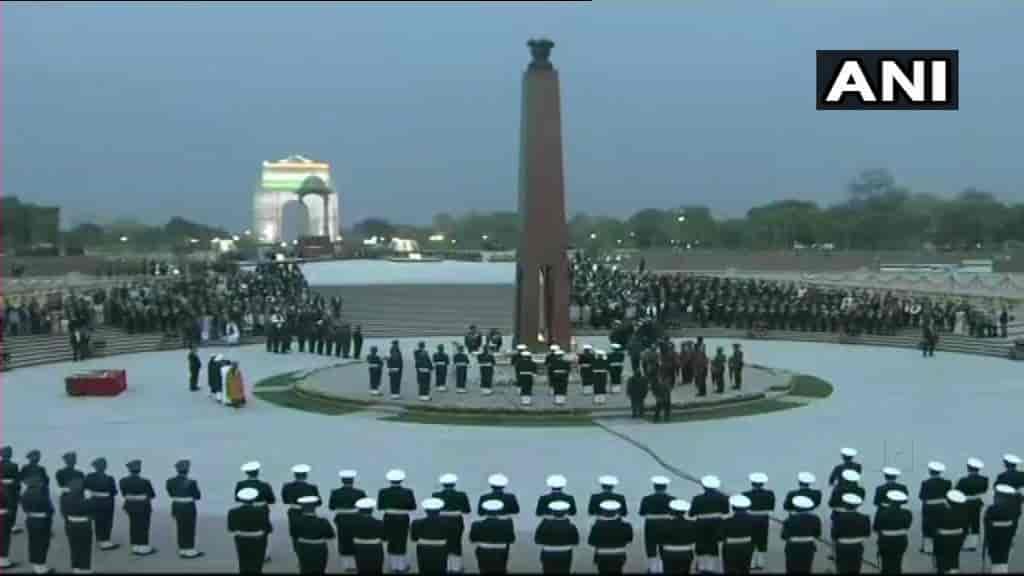The National War Memorial Delhi is the first epitome of bravery and commemorates the supreme sacrifices of and gallantry of the Indian soldiers. Since the independence of India The layout of the memorial is inspired from “Chakravyuh Formation” and it encompasses four concrete circles with a towering ceremonial obelisk having the eternal flame. The war memorial bears the names of the army personals who made supreme sacrifice in the wars with China and Pakistan as well as in some other important operations. National War Memorial was sanctioned by the Government of India in 2015 and was built near the India Gate vicinity called C-Hexagon.

Location of National War Museum –
The national war museum is located on the heart of New Delhi close to the Iconic India Gate. It is spread in an area of 40 acres of Land. It was complete in 2019 and subsequently unveiled on 25th Feb 2019 by the Prime Minister of India Mr. Narendra Modi.

Suggested tours
- 2 Days Delhi Tour Package
- Same Day Delhi Tour
- Old Delhi Tour
- Golden Triangle Tour Packages
- Taj Mahal Tour
- Car Rental in Delhi
National War Memorial Timings & Entry Fee
There is no entry fee to the National War memorial and it is open on the weekdays except certain restricted days. It normally takes 1 Hour to 2 Hours to visit it.
Months Timings
Nov-March 9 AM to 6:30 Pm
April-October 9 AM to 7:30 Pm
The Architecture of National war Memorial
The principal structure is erected in the shape of 4 Chakras which signify the various values of the Indian armed forces. The eternal flame (Amar Jawan Jyoti) and the obelisk one in the innermost concentric circle or chakra. The obelisk lies on an elevation of 15.5 meters and is visible from far. This is having the Ashokan capital at the top and the base bears the inscription “Shaheedon ki Chitaon per lagenge har varsh mele”
The architectural company of Chennai called web design labs was selected for the purpose of designing and construction of the national war museum. The chief architect of web design yogesh Chandrahasan envisaged to make this memorial a place of celebrating the gallentry of the martyrs rather making it a place for mourning. Under the bottom of eternal flame of the. The design of the central part has been made in the sunkar form to match with India gate and the Central Vista.

Read Suggested Blogs
- Monuments which Inspired Taj Mahal Architecture
- Red Fort Delhi History Timings
- Qutub Minar Delhi History and Timings
- Weekend Trip from Delhi
- Car Rental in India
4 Chakras of the National War memorial
- Amar Chakra– As the name signifies it is called the circle of immortality. In this Chakra in the main obelisk you can find the Amar Jawan Jyoti (Eternal Flame) incessantly burning. It denotes the Immortality of the spirit of soldiers and the gratitude of the nation towards them.
- Veerta Chakra– This is the circle of Bravery. This is a covered gallery showcasing the prominent bottles such as Longewala, Tithwal, operation meghdoot etc. This chakra has six burials made of bronze and it displays the famous battles fought by Indian army, Airforce and the Naval Force.
- Tyag Chakra– This is the circle of sacrifice. In this Chakra 16 walls are made in the form of concentric hide to pay homage to more than 25000 battle. The walls are covered with Granite tablets having the names of the soldiers.
- Rakshak Chakra– This is called the circle of protection. This outermost circle is made of rows of trees and assures the countryman against any external threats. Each tree is symbolic of one soldier.

Param Yodha Sthal
This part of the national war memorial has the busts of all the awardees of Param Vir Chakra which is the highest Gallantry award in India. PVC was instituted in 15th August 1947 by DR. Rajendra Prasad as the top gallantry medal. This medal was designed by Savitri Khanolkar.
Merger of Amar Jawan Jyoti–
In a historic move the famed Amr Jawan Jyoti is merged with the national War Museum. A torch of fire was lit with “Amar Jawan Jyoti” and was taken to the war museum with full ceremony and was merged with the eternal flame.
Amar jawan jyoti was constructed and inaugurated by the then Prime Minister of India in 26 Jan 1972. It was made as a memorial for the Indian soldiers who laid down their lives for the sake of nation in Indo-Pak in 1971.
Suggested Reading




